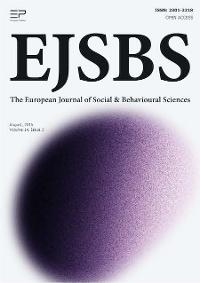Use of Drama Techniques among Teachers and Pupils’ Satisfaction with Extracurricular Activities in Croatia
Abstract
This paper includes results of two different research. The first one is considering primary grade teachers opinion about their competencies in Drama education. Drama art at a primary school in Croatia is taught as a part of theatre culture inside the curriculum of the mother tongue and literature and most often as an extracurricular activity. Extracurricular activities are an integral part of the Croatian educational system. Every pupil is free to choose, in addition to the regular school subjects, an extracurricular activity or more of their preference. The aim of the first research was to investigate the frequency, importance and variety of ways in which drama techniques are used in teaching. The analysis are based on the result of empirical research on a sample of 161 early primary grade teachers from 10 schools from Istra and Zagreb counties. It is proven wrong that frequency of using drama techniques in teaching is more frequent among teachers with shorter length in teaching and that frequency of using drama techniques in teaching is not more frequent among teachers with longer experience in drama extracurricular activities. This paper also presents the results of the second research about pupils’ satisfaction with basic aspects of extracurricular activities in the fourth grade of primary school. Extracurricular activities are provided by teachers in schools and partly by trainers or tutors of external courses at music schools, sports clubs etc. The research was done in eight schools in the county of Istria, Croatia. All pupils in this research (N=138) are included in extracurricular activities of some sort. In the paper, all the activities are divided in the following categories: arts, aesthetic education including literature, sports education, technical, ICT education, and others. Results consider only extracurricular activities provided in schools and show that there is a statistically significant difference in satisfaction with extracurricular activities between girls and boys. There is also a difference in satisfaction regarding the choice and type of extracurricular activities. The combining of the results in these two research gives a possibility to question how to strengthen teachers in their abilities to teach drama and perspective to analyse pupils’ satisfaction to improve teaching process.
Keywords: Drama education, extracurricular activities, drama techniques, pupils’ satisfaction
Introduction
Successful teachers’ role in satisfying educational goals implies, among other things, positive emotional environment. “The most important predictors of students' satisfaction with school are students' feelings that they are treated fairly, that they feel safe and that they believe that teachers are supportive” (Samdal et al., 1996). Assuming that teacher who feels competent would be a better motivator and supporter was my motive for the first research. “The function of drama teacher is to challenge, arouse interest, make anxious, give confidence, coordinate achievement, and encourage reflection. In any one lesson, he may operate in these varieties of other ways. No more than the maths or history teacher can he abdicate from his responsibility to assist and support his pupils in their learning” (O’Neill, Lambert, Linnell, & Warr-Wood, 1976). In this article, drama education is not considered as a tool for learning theatre-skills or interested in production. The accent was on diffusion of drama techniques in teaching and extracurricular activities and sense of competence in teaching this field of education. Drama education, as considered in this article, “…it is a set of methods that can be used in learning process using dramatic expression to grow and mature as a person through the ability to perceive, to understand the behavior of people and relationships” (Krušić, 2008). It is focused on learning process and critical thinking. “Drama creates dramatic situations to be explored by the participants, inviting them to find out more about the process of how the situation comes into being, to shift perspectives in the here and now, identify and sometimes solve problems and deepen our understanding of them” (DICE, 2008). Drama education is part of the modern educational paradigm that fosters learning through game and a holistic approach in education. Drama, especially actualized in extracurricular activities, provide the possibility for creative work and learning in a new way through experience. Pupils should satisfy their needs, deepen their interests and abilities to improve self-esteem and confidence. Drama Education has a wide application in education, either as a separate subject or as teaching methods within other subjects. Extracurricular activities are a part of school practice with no numerical rating; it is the area of free and independent choice. Their wealth of content and suitability to the needs and desires of specific school facilities provide an opportunity for individual development of each child, Martinčević (2010). Drama education as extracurricular activity is the part of the Croatian educational system that are ideal to bring together all of it because of the freer structure than in others subjects. ˝The first idea, one that today bears the significance of a viewpoint, from which one should commence both in discussion and in the construction of immediate pedagogical practice, is the idea that extracurricular activities are not lessons, but a special form of a school's pedagogical work˝ (Puževski, 1988, p. 26). The extracurricular curriculum is to be carried out through all school year in regular groups or during the holiday breaks or other festivities. Children are involved in different activities with a goal to get knowledge, habits and abilities to spend an active vacation Miliša (2000). Extracurricular activities, as we know them today, become a structurally significant part of the school system after 1953. when they were officially introduced in our school. Previšić (1985). It is different from country to country how much one invests in the development of extracurricular activities. According to Rajić et al. (2007), from 2003, the USA government invest 3, 6 billion (milliards) dollars in extracurricular projects to improve and allow their children to develop their interest and academically improve status, and their personal and social success. Puževski (1988) uses the term extracurricular activities to indicate “all the forms of activities, work and life that students of a school take part in and which are organized outside regular lessons (student groups, societies, organizations and communities)” (p. 24). These are planned educational endeavours that are realised within the framework of the school, outside regular lessons, and which provide an area of interest and an affirmation of a pupil's personality (Pejić-Papak & Vidulin-Orbanic, 2011). The goal of extracurricular activities is to initiate children to creation, gaining knowledge and competence according to their personal abilities and interest. This point of view was my motive for the second research on students’ satisfaction with extracurricular activities. The satisfaction as a key factor to the openness for learning and evolving. Mlinarević and Brust Nemet (2009), has done similar researches in Croatia. About the process of enhancing the quality of extra-curricular activities. That paper presents the reports of 284 students on their satisfaction with extra-curricular activities during the school year 2009/2010. in three rural and three urban elementary schools. The results show the number and frequency of extra-curricular activities and students’ satisfaction with the choice of extracurricular activities, suggesting new possibilities of organizing extra-curricular activities and reasons for the involvement of students in extracurricular activities. Same authors, Mlinarević and Brust Nemet (2011), have done another research about students’ estimates of the possibility of the co-constructing curriculum in extracurricular activities in primary school. In order to incite student’s creativity through extracurricular activities in elementary school. The level of possibility of students’ choices in school options in the curriculum construction and implementation activities and school factors that directly affect the flow and the performance of extracurricular activities has been explored.
Methodology and Results
The aim of this paper is to establish the relationship between using of drama techniques among teachers and pupils’ satisfaction with extracurricular activities. Assuming that satisfaction among pupils is highly based on teachers’ competence and motivation to teach drama. Even thou the results are more general, not only considering drama, in this paper I try to observe these two educational positions and try to think of better ways to improve teachers’ competence and pupils’ satisfaction in educational process.
For both the of the researches, questionnaires were made. The questionnaires consisted of a general section (the years of work in teaching, conducting drama groups as part of extra-curricular activities, and professional training in the field of drama education, or number and type of extracurricular activities attended…). Both questioners contained and multiple-choice questions that were related to the use of different methods in drama teaching and extracurricular work or preferences in extracurricular classes. On a scale Likert of 5 degrees (0 - strongly disagree, to 4 - 1 completely agree), teachers and pupils have expressed their agreement with statements about the impact of drama education to develop students' individual competencies and qualities or satisfaction with specific aspects of extracurricular activities. The interrogation lasted for 10-15 minutes and was anonymous and voluntarily. The first research involved 161 primary school teachers 100% female from ten schools from Istra and Zagreb County, Croatia. The second research involved 138 pupils of four graders from eight elementary schools of Istra County, Croatia. From it 70 male (50.7%) and 68 female (49.3%)
From the research problems of this paper, these hypotheses were made:
H1 Frequency of using drama techniques in teaching is more frequent among teachers with shorter length in teaching.
H2 Frequency of using drama techniques in teaching is more frequent among teachers with longer experience in drama extracurricular activities.
Both of them have been proven wrong.
H3 There is the difference in satisfaction with extracurricular activities regarding pupils’ gender.
H4 There is the difference in satisfaction with extracurricular activities regarding chosen extracurricular activities.
Both of them have been proven right.
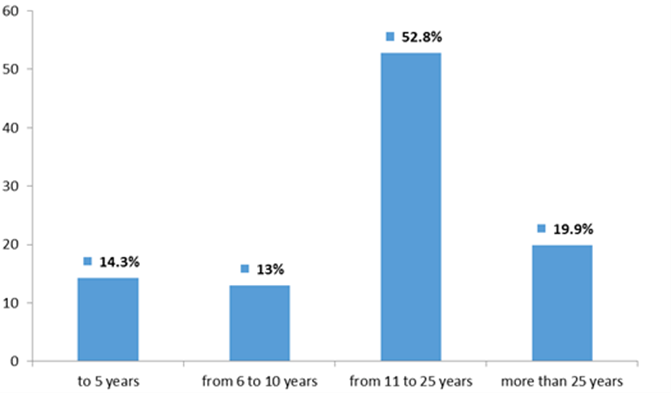
It is shown in figure 1 that 52.8% (N=85), has between 11 and 25 years of work experience, followed by those of 25 years of work experience, or 19,9% (N=32). Than teachers to 5 years of work experience, or 14,3% (N=23) and those from 6 to 10 years of work experience, or 13% (N=21).
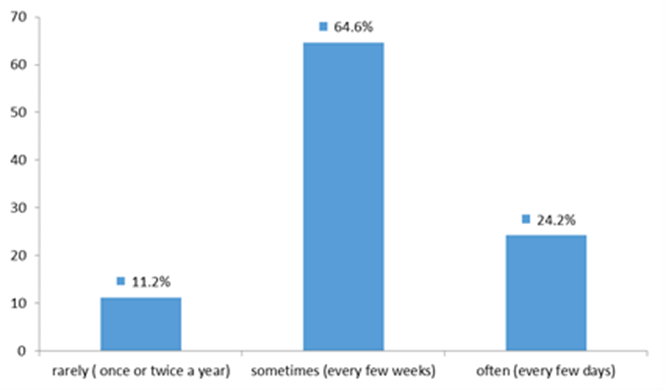
It is shown in figure 2 that majority of teachers, them 64,6% (N=104) is using drama techniques every few weeks. Every few days uses them 24,2% (N=39), and using them once or twice a year is using 11,2% of teachers (N=18).
It is apparent that the average number of the dramatic method is used the same, regardless of years of service of the respondents. That is confirmed by one-way analysis of variance (ANOVA) (see table 2).
There is no statistical significance in a number of dramatic methods used in regard of the duration of the respondents work experience (F=0,594, df=3, p>0.05).
Hypothesis of using drama techniques in teaching is more frequent among teachers with shorter length in teaching is supposed because thought that teaching methods and approaches of using drama in teachers’ universities has developed and given it more significance (see figure 3).
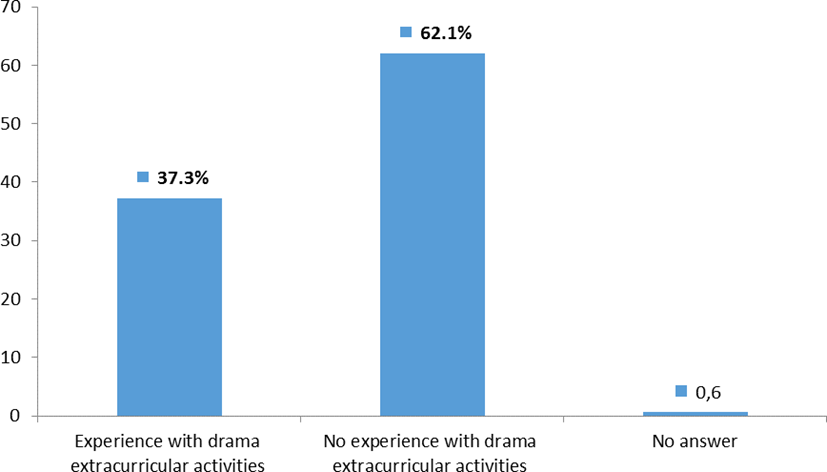
It is shown in table 3 that all the teachers who have the experience with drama extracurricular activities uses drama techniques in teaching, (N=59, or 100%). Most of the teachers who has no experience with drama extracurricular activities also uses drama techniques in teaching (N=87, or 89.69%), only (N=10, or 10.31%) does not use drama techniques in teaching.
This hypothesis was made because it was thought that teachers who practice drama techniques and methods in extracurricular activities would use it more in teaching other subjects. This was not proven right. It was also asked to teachers if they feel competent to teach Drama. Although most respondents use drama techniques in their work, unfortunately, most of the respondents 80.7% (N = 130) are not considered competent to teach Drama, because they think that are not educated enough. Only 17.4% of respondents consider themselves competent enough (N = 28), because of many years of experience and having seminar education. This question is not answered by one respondent.
The second part of research is realized among pupils who in most cases go to one extracurricular activities outside of school (N=104; 75, 4%), some of them two (N=21; 15.2%) and only one pupil goes to three activities.
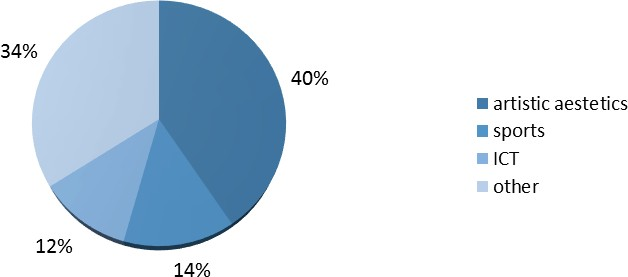
From 179 questioned pupils, everyone attends extracurricular activities in school. The most numerous attendance is to artistic aesthetics group of activities (N=56; 40.6%), sports activities follows (N=19; 13.8%), then ICT activities (N=16, 11.6%) and other (N=47; 34.1%) as seen in figure 4. Sports extracurricular activities include sports group and chess. ICT include informatics group. Other extracurricular activities include the mixed group (meaning that whole class is in one extracurricular activity that is guided by the class teacher and involves various activities from sports to artistic one), sign language and librarian group.
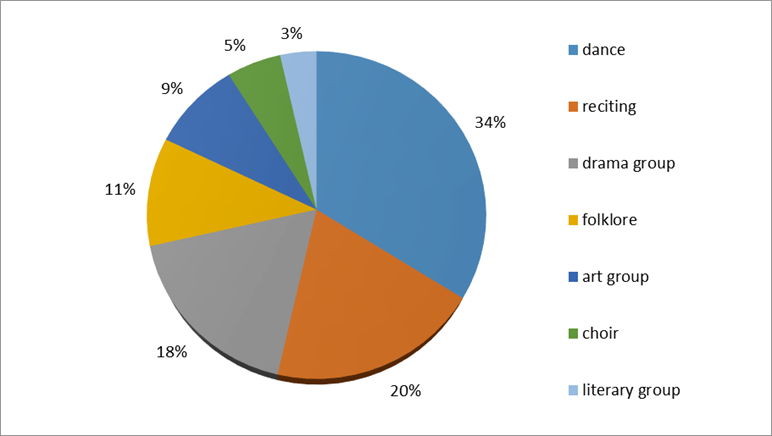
The most numerous extracurricular activities are artistic aesthetic activities. Figure 5. shows that artistic aesthetic extracurricular activities include: drama, reciting, art group, a literary group, choir, folklore and dance. The difference in pupils' satisfaction has been examined in relation to gender and extracurricular activity choice. A t-test was used for independent samples (gender) and one- way analysis of variance (extracurricular activity choice). Table 4 provides insight into the descriptive data with regard to gender.
There is a statistically significant difference in satisfaction with extracurricular activities between girls and boys (t=2.06; p<0.05). Females are more satisfied with extracurricular activities (M=165.65; SD=18.60) than males (M=158.61; SD=21.44).
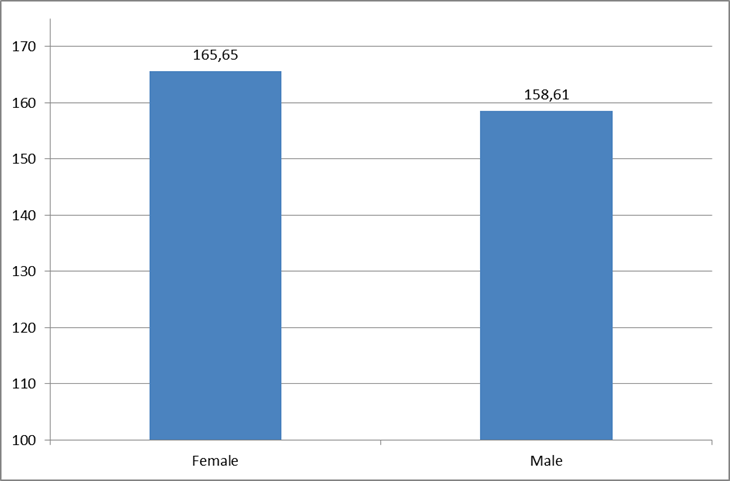
Interested to see if there is a connection between 100 percentage female teachers and more satisfaction in attending extracurricular activities such as drama among female students. The issue of lacking boys in drama classes is not only typical for Croatia; Lucy Kerbel (2011) is giving the reasons, which were “…commonly identified for a lack of boys in youth drama. The first, according to the research participants, is that at a young age, boys tend to be encouraged by parents towards sport and girls towards dance and drama. This means that when boys reach youth drama age, habits have been formed, the sport takes up much of their free time and taking up a completely new hobby is less likely. Meanwhile, for those girls who have always participated in dance and drama, segueing into youth drama feels like a far easier and more predictable transition. The second reason offered was that for many boys, participating in drama is not socially acceptable. Fear of homosexual bullying was cited as the main reason boys are reticent to take part in youth drama (or indeed most types of performing arts activity) and it was suggested that pressure on boys not to take part could come from a combination of peers, teachers and parents. Additionally, the suggestion was made that it was less acceptable for boys to be seen as emotionally expressive, whereas this was not the case for girls” (Kerbel, 2012).
There is also a statistically significant difference in satisfaction with extracurricular activities in relationship to chosen extracurricular activity (F=4.12; SS=3,134; p<0.01). Pupils in artistic aesthetic activities are more satisfied (M=168.66; SD=18.14) than pupils who chose other activities (M=156.09; SD=19.06). There isn’t a statistically significant difference between other extracurricular activities.
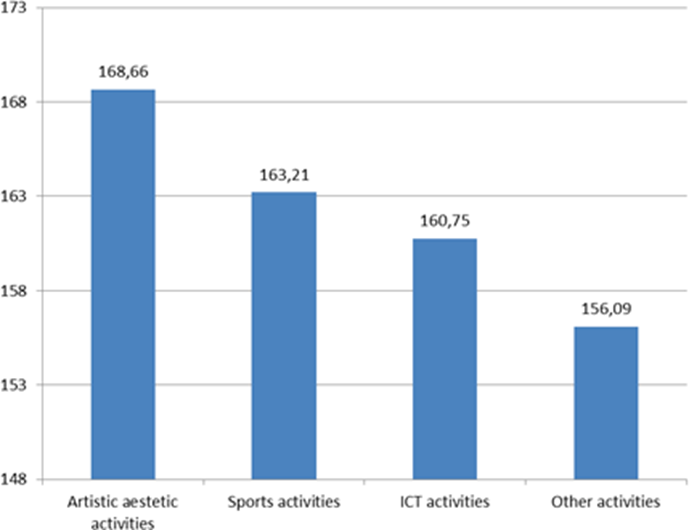
It is also true that girls chose artistic aesthetic activities in greater number (N=45) than boys (N=11). There are differences in involvement with sports activities. Boys are numerous (N= 18) than girls (N=1) in sports.
Conclusion
This research shows that drama education has very widespread use in class teaching as particular subject or as a part of teaching method in others subjects in Croatia. It is an integral part of the contemporary educational paradigm that enables teachings through experience, game and holistic approach. Nevertheless, can we expected improvement if teachers consider themselves not competent to teach Drama education? This is something to be considered in relation to other research, because if the teachers are not motivated enough to become competent how can we expect that pupils will be content with extracurricular activities which are the only free subject that they can choose. The results of this research have proven that there is statistically significant difference with extracurricular activities regarding pupils’ gender. Girls are more satisfied with extracurricular activities than boys are. There is also found statistically significant difference in satisfaction with extracurricular activities regarding chosen extracurricular activities. It shows that pupils who chose artistic aesthetic extracurricular activities are more satisfied with their choice than others are.
It is also fact that girls choose most the artistic aesthetic activities, so the correlation between two hypotheses is also possible. What does it mean? Is the choice of activities provided in schools more suited for girls? These kinds of insights give us a possibility of rethinking the performance, content and organization of extracurricular activity because its purpose and value are very important for child development.
Acknowledgements
The author(s) declare that there is no conflict of interest.
References
DICE Drama Improves Lisbon Key Competences in Education (2008-2010). /online/. 12. January 2015. http://www.dramanetwork.eu/
Kerbel, L. (2012). Swimming in the shallow end. Opportunities for girls in youth drama, focusing on the quantity and quality of roles available to them /online/. 15. January 2015. http://www.tonictheatre.co.uk/
Krušić, V. (2008). The posibilities of drama. Croatian Centre for Drama Education. /online/. 2. September 2012. http://www.hcdo.hr/
Martinčević, J. (2010). Extracurricular activities as a factor of education for a leisure time, Life and School, Journal for the Theory and Practice of Education, Ladislav Bognar, Faculty of philosophy Osijek, Faculty of education in Osijek, 24(2) 19- 34.
Miliša, Z. (2000). (ur.) Croatian Education Report. Department of Education Development, Zagreb.
Mlinarević, V., & Brust Nemet, M. (2009). The quality of the implementation of the school’s extracurricular activities, Faculty of Teacher Education in Osijek. http://bib.irb.hr/datoteka/481572.Mlinarevi_Brust_-_Kvaliteta_provedbe.pdf
Mlinarević, V., & Brust Nemet, M. (2011). Active participants of the process of enhancing quality of extra-curricular activities, Teacher Education in Osijek. http://bib.irb.hr/datoteka/507176.KONF_2011_Mlinarevic_Brust_Nemet.
O’Neill, C., Lambert, A., Linnell, R., & Warr-Wood, J. (1976). Drama guidelines. London Drama.
Pejic-Papak, P., & Vidulin-Orbanic, S. (2011). Stimulating Active Learning In Extracurricular Activities Through Contemporary Work Strategies. Methodological Horizons. University of Juraj Dobrila Pula. The Department of Preschool and Primary Education 12(6), 2. DOI:
Previšić, V. (1985). Extracurricular activities in education. Education and schools. Zagreb. Institute for pedagogical research, 426-431.
Samdal, O., Nutbeam, D., Wold, B., & Kannas, L. (1998). Achieving health and educational goals through schools – a study of the importance of the school climate and the students' satisfaction with school. DOI:
Copyright information

This work is licensed under a Creative Commons Attribution-NonCommercial-NoDerivatives 4.0 International License.


